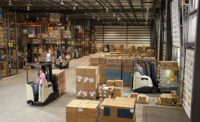Operational efficiency is the mantra for every company, but for refrigerated and frozen food processors, warehouse space is even more important.
“Square foot usage of space and how [refrigerated and frozen food processors] manage the operations within those areas are very, very keen to them because it’s very expensive to build and run those types of facilities,” says Tom Kozenski, vice president of solutions strategy at JDA Software, Scottsdale, Ariz.
That’s why cold food processors are always looking for more information, more technology and more solutions, so they can make better decisions on inventory levels, delivery times, labor requirements and customer satisfaction.
Government regulation pushes for innovation
While many cold food processors need real-time software solutions to better manage their supply chains, several drivers are helping push the envelope when it comes to innovation.
“Increased regulatory changes in food safety and security impact how food is shipped and stored,” says Chris Castaldi, director of business development for W&H Systems, Carlstadt, N.J. “Traceability within food and beverage processors is becoming a requirement for meeting government regulations, and there is a growing need to know where the products are at all times. This requires innovation to trace food products from farm to fork.”
Food and beverage processors also must make the most use of their warehouse, so they look for systems that maximize cube space and maximize density, Castaldi says.
For its part, W&H Systems offers a warehouse control system for food and beverage processors called Shiraz. It directs operations for returns, shipping and manifesting, labeling, packing, order consolidation, labor and task management, packaging sortation and order picking.
“Shiraz fulfillment concepts must be flexible and able to pick slow-, medium- and fast-moving products, and then pack them via manual, semi-automated or automated packing procedures,” Castaldi says. “Because of the variety of fulfillment requirements, Shiraz is available in three modes, ranging from the ability to handle from 8,000-100,000 items per day.”
Tracking business intelligence
Business intelligence is also of upmost importance to refrigerated and frozen food processors, according to Andy Hedrick, marketing alliance director for Appian Software by TMW Systems Inc., Beachwood, Ohio.
“Executives want to see how they are performing and how they are trending on a cost per case,” he adds. “They want capacity utilization on their trucks. Do they have too many? Do they have the wrong types of trucks?”
In addition, many processors are moving to online schedule visibility and business intelligence accessible through log-ins. Automated notification to customers based on estimated time of arrival (ETA) being updated throughout the day is advancing the market, says Hedrick.
“Companies used to have to call into a customer service rep,” he says. “They would have to call a dispatch, and a dispatch would call a driver on a phone. Now you can go online to see updated ETAs or get an email or a text notification on the status of your order, so that’s really changing the whole landscape.”
TMW Systems also offers a host of automated route planning, automated analysis tools, online business intelligence and online execution tools. The key is fewer steps to process fleet routing and providing executives with quick access to high-level dashboard reporting, Hedrick says.
Growing consumer preferences are placing an increasing strain on the cold chain as well.
“This, in turn, forces us to examine all processes in an effort to increase reliability, minimize safety events and reduce disruptions,” says Mike Zeinfeld, president of Thabble, Melrose Park, Ill. “We believe in the near future, every element, every interaction of the cold chain will be monitored, either directly or indirectly using an arsenal of sensors and software. From terrorism to severe weather, monitoring can help diagnose, alert and even predict events before they occur.”
That’s why Thabble offers Thing Relationship relationship management software that continuously monitors and identifies every person, place and asset that interacts with logistics, warehouse and manufacturing operations. Thabble searches data from various sources to create an organized set of data, which can be shared safely with employees, partners, manufacturers, consultants and third-party software providers, such as transportation management and sensor solutions.
“An evolution is in the making with regards to sensors, such as temperature sensors, RFID, GPS, Bluetooth low-energy devices, video cameras, door sensors and mobile phones,” adds Zeinfeld.
Thabble also developed Equipstick, a sensor that tracks the motion and vibration of any person, place or asset in a facility.
“Now, you can track utilization and productivity of working assets (e.g., forklifts, employees) with virtually no setup and minimal ongoing cost,” adds Zeinfeld.
Private fleet management
Furthermore, demand for innovation in logistics and IT encourages software providers to develop products that allow cold food processors to achieve more with less, says Anthony Vitiello, director of marketing at UltraShipTMS Inc., Fair Lawn, N.J.
“The utilization of private fleets is on the rise among food shippers grappling with the shorter shelf life of fresh products and the ongoing capacity crunch afflicting [over-the-road] trucking in North America,” Vitiello says. “By building and maintaining even a small private fleet, food shippers can retain guaranteed capacity for at least their most critical and time-sensitive deliveries.”
As a result, UltraShipTMS developed a suite of private fleet management functions into its TMS platform so that all movements—whether via common carrier or fleet—can be managed from a single platform.
For example, the UltraYMS yard management solution “helps to streamline the processes involved with timely loading and unloading. YMS is useful in equipment positioning, ensuring for example there are trailers available, reducing dock congestion and optimizing door utilization,” Vitiello says.
Another feature is gate management, which logs all vehicles passing into and out of the yard, captures photographic record of loaded shipments as they leave the yard and verifies the lock and seal of inbound and outbound shipments. Gate management also provides both increased visibility into where loads are in the transportation process and accountability to help reduce over, short or damaged claims and theft, Vitiello says.
Reducing the cost of service
For Canada-based Maves International Software, it’s all about reducing the cost of providing service, says Aaron Laird, president. As a result, Maves International focuses primarily on increased flexibility to handle order size, whether it is bringing goods into the warehouse or shipping goods out.
“This requires you to look at orders and even receipts not in a transaction as a whole, but more as individual things that you have to do, basically down to the product level, maybe even down to the location where it is stored,” he adds. “Of course, there are ever-increasing demands to attach and track attributes on products, so you not only have to know the expiration date, you [also] have to know the best before date. You have to recognize these things many times based on the end consumers’ view.”
Visibility improves innovation
Visibility of operational data, both inside the production and distribution facility, also is key to supply chain software innovation.
“You need to be able to make decisions quickly to be able to react to trends that you are seeing in how you are performing your service and what the demands are,” Laird adds.
Changing needs in terms of delivery size and frequency combined with fuel costs and increased competition are said to be big transportation challenges facing cold food producers today, says William Salter, president and CEO of Paragon Software Systems Inc., UK.
“We are seeing more and more customers faced with an increased demand from their customers for tighter delivery time windows and often more frequent deliveries,” he says. “For example, larger deliveries being split into more frequent, but smaller volume drops.”
Due to the competitive nature of the market, suppliers need to ensure that their products are on store shelves when consumers want to buy them as well, Salter says. Based off an algorithm designed specifically for optimizing road-based transportation operations, Paragon’s software uses digital mapping to calculate the most effective delivery and collection sequences with accurate journey times, allocating loads to appropriate vehicles and drivers accordingly.
“This ensures that the schedules are geographically feasible to meet promised arrival time windows, while improving fleet utilization and productivity through efficient routes with minimal total mileage incurred and empty running reduced,” Salter says.
Paragon’s Fleet Controller integrates with the company’s routing, scheduling and transportation optimization systems, analyzing vehicle location and status information via real-time satellite communications.
Paragon also offers an “arrivals board” functionality that links to satellite vehicle tracking using Fleet Controller. This provides continually updated visual ETAs to store staff, informing when the delivery will arrive and precisely what is on the vehicle.
Increased automation
HighJump Software, Minneapolis, is seeing two key trends in refrigerated logistics—direct-store-delivery and more automation technologies, whether it is rotation equipment, automated pick-and-retrieval systems or voice solutions.
“A higher level of automation is becoming more common in North America,” says Ross Elliott, chief strategy officer for HighJump. “This has usually been the case in Europe, but the United States is now seeing more companies considering and deploying automation. We are also seeing processors increasing their direct-store-delivery segment and experimentation with direct-to-consumer shipping, which places a different level of demand logistics professionals.”
Another trend is toward designing, building and delivering a perfect pallet to an end consignee, according to Elliott.
“These are complex pallets due to the specific needs of each delivery point,” he says. “We now see the need for consignee-specific product shelf life while also having mixed products on a single pallet that takes into account product density for stacking, pallet heights due to limitations of the store or location receiving goods and specific pallet wood that meets the end consignee profile or specifications. For shipments direct to stores, you also have constraint of delivery appointment times.”
HighJump’s HighJumpOne suite of supply chain solutions addresses the growing demand for information transparency at the point of execution.
“Handhelds in the refrigerated and frozen segment have been limited to traditional telnet or Windows mobile/CE devices,” Elliott says. “Newer devices like the Panasonic Toughpad FZ-E1 provide full Windows 8.1 mobile capability with support for -4°F operation. That gives us the opportunity to deliver the full HighJumpOne mobile user experience to deliver order status information, quality inspection tests, appointment schedules, etc., to anyone whether they’re in the freezer or on the floor.”
HighJump also offers improved traceability and tracking information at an end product level.
“Within the distribution center, we have enhanced our capabilities around tracking and tracing of products all the way from the front end of the supply chain in terms of what might have been the raw materials or raw goods that went into making of product as well as downstream where that was ultimately shipped,” says Chuck Fuerst, director of product strategy for HighJump.
Work smarter, not harder
Lastly, labor management software forces employees to work smarter, not harder, according to Kozenski from JDA Software.
“It’s actually a tool that identifies what I like to call ‘barrier to productivity’ on behalf of the company,” Kozenski says. “They can gain more efficiency from workers where workers are still working at a normal pace and putting in the normal level of effort, but are doing their jobs much more efficiently, squeezing seconds and minutes out of their operation, therefore making themselves more productive and increasing the overall facility input.”
Today’s logistics software provides more information, technology and solutions than ever before, so refrigerated and frozen food processors can make better supply chain management decisions.






